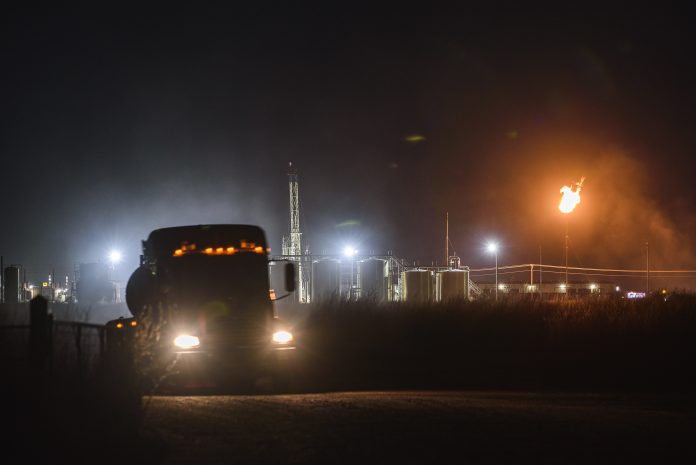
The Asia-Pacific nations are spewing more carbon dioxide into the air than any other region in the world, but the very compliant Permian Basin and other top American oil- and natural gas-producing areas are still taking it in the neck from federal regulators because they’re sitting ducks.
Nations that aren’t members of the Organization for Economic Cooperation and Development are fouling the atmosphere willy-nilly and Odessa oilman Kirk Edwards, Waco economist Ray Perryman and 2023 Permian Basin International Oil Show President Larry Edwards say China, India, Russia and the others don’t give a hoot.

“It’s interesting how many parts of the world, including the United States, are drastically reducing the amounts of so-called greenhouse gas emissions while other parts, mainly China, are doing their best to put more and more emissions into the air,” Edwards said. “This world cannot have a net reduction in greenhouse gas emissions when China is building a new coal plant literally every week and connecting it to their electric grid.
“China doesn’t care about any accord that others on this earth have towards that goal. They don’t care about Ukraine’s people being slaughtered as they buy cheap Russian oil on the black market. So the conclusion of this is that there will never be a net lowering of emissions if China and other emerging countries are not on board. And there is no way they will be on board anytime soon. They simply don’t care.”
The European Commission’s Emissions Control Database for Global Atmospheric Research (EDGAR) says China, India, Russia, Iran, Saudi Arabia, Brazil and Turkey all had higher CO2 emissions in 2021 than in 2019 with Turkey’s 7.9 percent being the biggest bump.
EDGAR reports that biennial decreases were achieved by the United States, Japan, South Korea, Indonesia, Canada, South Africa, Australia, Mexico and the 27 EU nations with Mexico’s 13-percent reduction leading the way.
Perryman said emissions are rising in many nations as a natural product of population growth and economic development.

“For example China’s CO2 emissions are already twice as high as the United States’ but China is constructing substantial coal-fired electric power generation facilities on a continuing basis as well as supporting similar facilities in other areas,” Perryman said.
“Some countries are rising from extremely low levels of emissions simply because they are finally seeing some industrial development, wage growth and a resulting increase in wealth.
“Such increases in emissions, while regrettable, are helping to solve other major world problems such as extreme poverty and hunger. Other nations like China are more developed but are still willing to increase emissions to achieve economic growth and the resulting power on the world stage.”
Perryman said many of the offending countries are on record as working to reduce emissions, but they are willing to push meaningful reductions into the future to avoid having their people starve or to see economic growth constrained.
“In a broader context it is imperative that we both address the climate situation and assure adequate energy resources to support growth and emerging prosperity for billions of impoverished people,” he said. “It seems that policies all too often address one of these issues and ignore the other. We need comprehensive approaches which recognize both realities. In the language of algebra the world is facing a simultaneous problem.”
Perryman said there is realistically little the U.S. or other OECD countries can do to compel compliance with climate goals particularly if policies are not cognizant of energy needs.
“The emerging countries in Asia and elsewhere are sovereign nations and the scope of actions that could be taken is obviously limited to working toward sustainable climate agreements and incentivizing compliance to the extent possible, possibly through financial means,” he said. “Other important actions include research and development into a variety of methods of reducing emissions from better and cheaper ways to burn fuels cleaner to more efficient power generation capabilities.
“Ideally investments will go in directions that make the most difference in terms of bang for the buck in countries where emissions are most likely to rise rapidly. This is a complex issue that requires a multi-faceted approach.”
Richards said one of the largest challenges in the Asia-Pacific region of the globe is tied to its greatest opportunities.

“You can’t blame countries for wanting to provide a better standard of living and low-cost energy to their growing populations, but we can help them convert to technologies with lower greenhouse gas emissions,” he said. “Coal-fired power plants are still the norm in much of this region, producing the highest amount of greenhouse gases of any fossil fuel per kilowatt of energy produced.
“Meanwhile vast amounts of natural gas, primarily methane, are vented and flared by the national oil companies in much of the region. When vented, methane gas has over 30 times the greenhouse gas effect of CO2, allowing for huge improvements in greenhouse gas emissions when methane emissions are targeted.
“When used in power plants methane gas is the cleanest burning of any fossil fuel. Because it’s produced as associated gas in many of these nations with their oil production much of it is currently vented to the atmosphere or flared as a nuisance product.”
Richards said the worst polluting countries “have an opportunity for a huge win-win by capturing this methane gas and using it to convert their electric power system away from coal-fired plants.
“These type projects are the low-hanging fruit for reducing global greenhouse gas emissions with the potential for massive volume impacts in a very short time period,” he said. “Hopefully the U.S. can assist with sharing best practices and lessons learned from our industry’s successful targeting and use of these previously wasted methane gas streams in a way that can reduce the learning curve and the acceptance of new approaches and technologies.”



